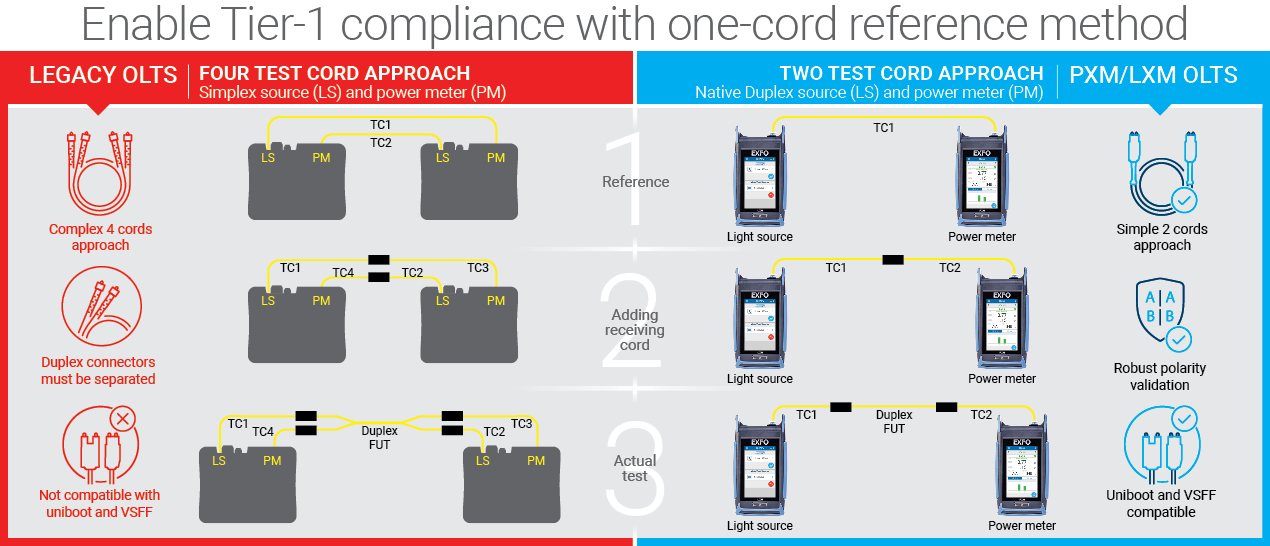Why is one-cord referencing crucial for efficiency in deploying data center networks?
In the world of data centers with high-speed and high-density fiber networks, efficiency and accuracy are paramount. As the demand for faster deployments grows, so does the need for tools and methodologies that streamline the testing process. With the appearance of various connector types for duplex communication, testing has become complex. For instance, complying with recommended one-cord reference method has become impossible using legacy test instruments. Using optical loss test set (OLTS) designed for today’s connectivity is the only way to fully comply with the one-cord reference method. But what is the one-cord reference method, and why is it so critical for efficient and reliable deployments? Let’s break it down.
The fundamentals of fiber testing
When installing or maintaining a fiber-optic network, technicians need to test the cables to make sure they work properly. This involves checking three main things:
- Link loss: How much signal gets lost as light travels through the fiber.
- Length: The total fiber length, which impacts signal attenuation and is crucial for verifying proper installation.
- Polarity: Making sure the transmitted signal will reach the receiver at the end of the link.
These tests ensure that the network will perform as expected and meet industry standards. Traditionally, setting up these tests could be tricky, involving different cords and adapters depending on the type of connectors used. That’s where one-cord referencing greatly simplifies things.
What is one-cord referencing?
Imagine you’re cutting two pieces of wood to the same length. Instead of measuring each piece separately, which could lead to slight differences, you use a single guide to measure and cut both pieces precisely. This ensures consistency and saves time. Duplex one-cord referencing works similarly in fiber testing: it uses one cord to handle both the TX (transmit) and RX (receive) paths of a duplex cable, ensuring precise and consistent measurements without the need for multiple cords or adapters.

Why is one-cord referencing important?
It ensures standards compliance
Fiber-optic networks must meet strict standards, like those set by TIA, ISO, and IEC. For example, TIA specifies methods to ensure accurate testing and certification of optical fiber installations. Using one-cord referencing complies with these standards by minimizing the variability caused by multiple cords or adapters. With fewer connections, the reference loss measurement aligns more closely with TIA’s requirement for precise and consistent testing practices.
It saves time
Every second counts in data center builds and fiber installations. Traditional referencing methods often require multiple cords and reconfiguration when switching between connector types. With one-cord referencing, these steps are minimized, allowing technicians to complete tests faster and move on to the next task.
It improves accuracy and repeatability
Every time you add a cord or adapter to your test setup; you’re introducing the possibility of errors. Extra connections can affect your results, leading to inaccurate measurements. With one-cord referencing, you reduce the number of connections, which means more consistent results and fewer mistakes.
It’s easier to learn and use
If you’re new to fiber testing, the fewer steps there are, the better. Traditional setups can feel overwhelming with all the cords and adapters. One-cord referencing simplifies the process so you can focus on the results instead of the setup.
A real-world example
Let’s say you’re testing a duplex fiber cable in a data center. The cable has connectors on both ends that need to match for transmit and receive signals. With traditional methods, you might need different cords to handle different connector types. This adds on complexity, making it difficult to achieve robust polarity validation as users may easily reverse test cords during manipulations. But with duplex one-cord referencing, you can quickly test both paths with one cord getting the robust polarity validation required to ensure TX (transmit) will communicate with RX (receive) on the other end. Using one-cord referencing also increases accuracy by reducing the number of test cords used. You save time, reduce errors, and get reliable results.
A giant breakthrough in testing very small form factors (VSFF)
The innovative capability for an OLTS to perform one-cord referencing for duplex cables, including uniboot and VSFF, marks a significant milestone in the industry. This advancement provides data center operators with a practical way to validate and adopt VSFF technologies with confidence, ensuring their networks meet evolving high-density fiber requirements. Additionally, contractors equipped with EXFO’s PXM/LXM OLTS and the FIP-500 inspection scope can further differentiate themselves from the competition by offering comprehensive testing and certification for VSFF and other high-density connectors. This capability not only streamlines testing but also drives business opportunities by enabling faster, more accurate fiber deployments.
The future of fiber testing
As networks become faster and more complex, testing methods need to keep up. One-cord referencing isn’t a buzz word—it’s a smarter, faster way to test optical cables. It empowers technicians of any experience level in getting the job done more efficiently. If you’re looking for a way to simplify your fiber testing process, consider exploring tools that offer one-cord referencing such as EXFO’s PXM/LXM duplex and multi-fiber OLTS. The right tools don’t just speed up testing—they set the standard.




